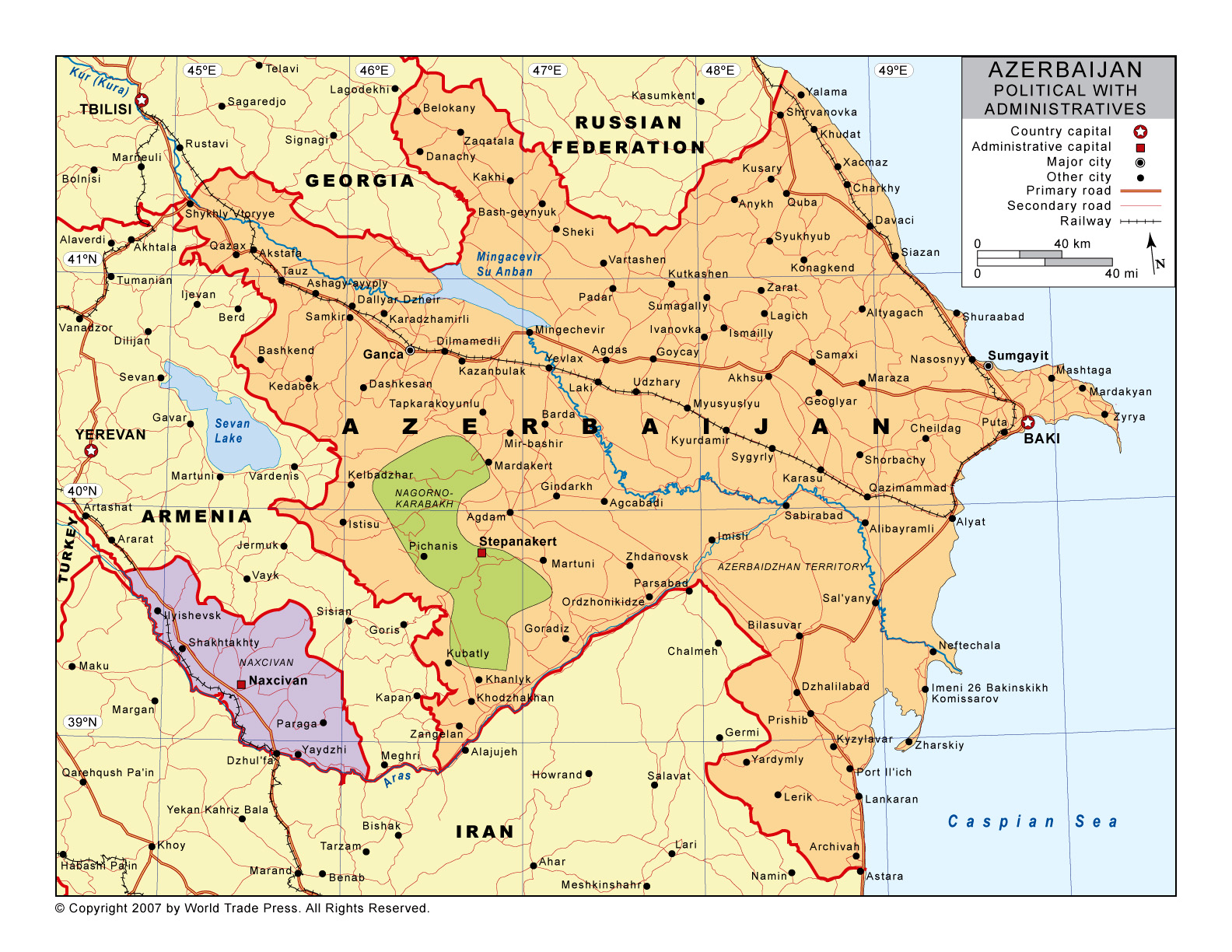By Mary Kay Seales
First of all, let’s address the obvious. Where the heck is Azerbaijan?
Most people I talk to in the U.S. have no idea where Azerbaijan is, or even that a country by this name exists. Honestly, I admit to having to look it up when I was offered a position teaching there two years ago.
On a map, it is the jigsaw puzzle-piece in the landscape near the Caspian Sea, bordered mainly by Russia, Georgia, Armenia, and Iran. There’s also a tiny piece of Azerbaijan within the country of Armenia (the little purple piece in the map above), which shares a border with Turkey and Iran. Conflict between Azerbaijan and Armenia is the norm, with major clashes as recently as 2016.
Other than that, what’s it’s like in Azerbaijan?
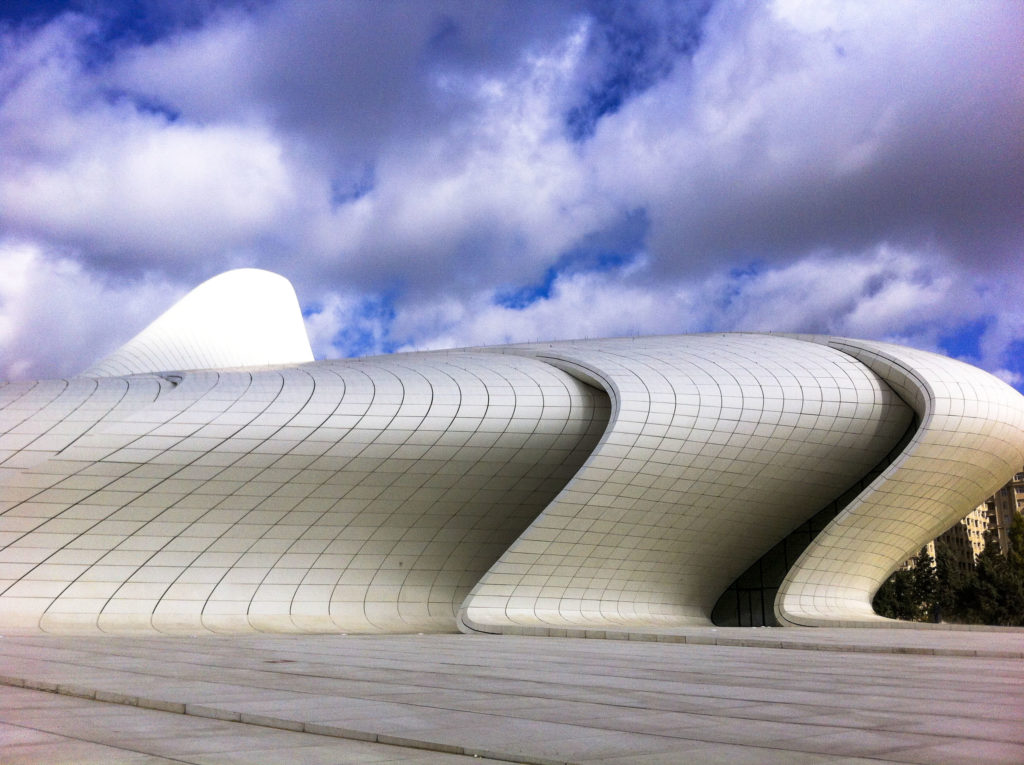
From my short stay of four months, Azerbaijan is a country of contradictions:
- It’s a predominantly Muslim country with few mosques or headscarves, at least in the capital city of Baku. As one woman I met told me, “It’s a Muslim country, but you wouldn’t know it.”
- Azerbaijan is a center for award-winning architecture on a grand scale, but with many people living in relative poverty. The most spectacular building I’ve ever seen (photo above) is in Baku.
- There are colleges for oil engineering supported by oil giant BP, but no databases in their libraries or internet in the classrooms.
- Baku boasts many beautiful modern skyscrapers and hotels, and chic boutiques with the latest Paris fashion, but also an ancient walled city with a Maiden Tower and carpet merchants.
Azerbaijan is weirdly modern and ancient at the same time. It’s not yet been 30 years since its independence from Russia, yet it has a culture thousands of years old. As one of my students remarked, “We are a young country. You must give us time.”
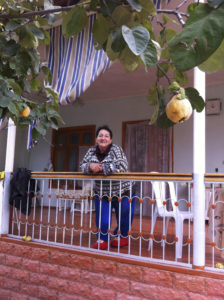
Odd and lovely moments
Likewise, living and working in Azerbaijan at a small college was a somewhat crazy, eye-opening and yet beautiful experience filled with hundreds of odd and lovely moments. One of these moments was my meal at a restaurant named Bizim Bagh, in Goyçhay, a little town about 100 kilometers from Baku. I had been invited to Goyçay for the weekend by two women, Firengiz and Kamala, both members of the faculty at the university where I was teaching.
Let me just add that I was a bit nervous about leaving the city. This was 2014 and there had been recent news stories about problems with ISIS. My family was sure that I would be kidnapped, and almost didn’t let me on the plane.
I did let my imagination go a bit wild at the time. It was silly, but the fear was real. I laid awake the first night I was in Goyçay in Firengiz’s little country cottage, as she called it, wondering not if they were coming to kidnap me, but when. I had worked out elaborate schemes of escaping, knowing I was doomed anyway if I escaped in a place where no one spoke English, and I was a complete outsider.
Again, there was absolutely no need for this fear, but I did feel like a sitting duck. It’s unfortunate we have these unwarranted feelings.
Dinner at Fuad’s in the garden
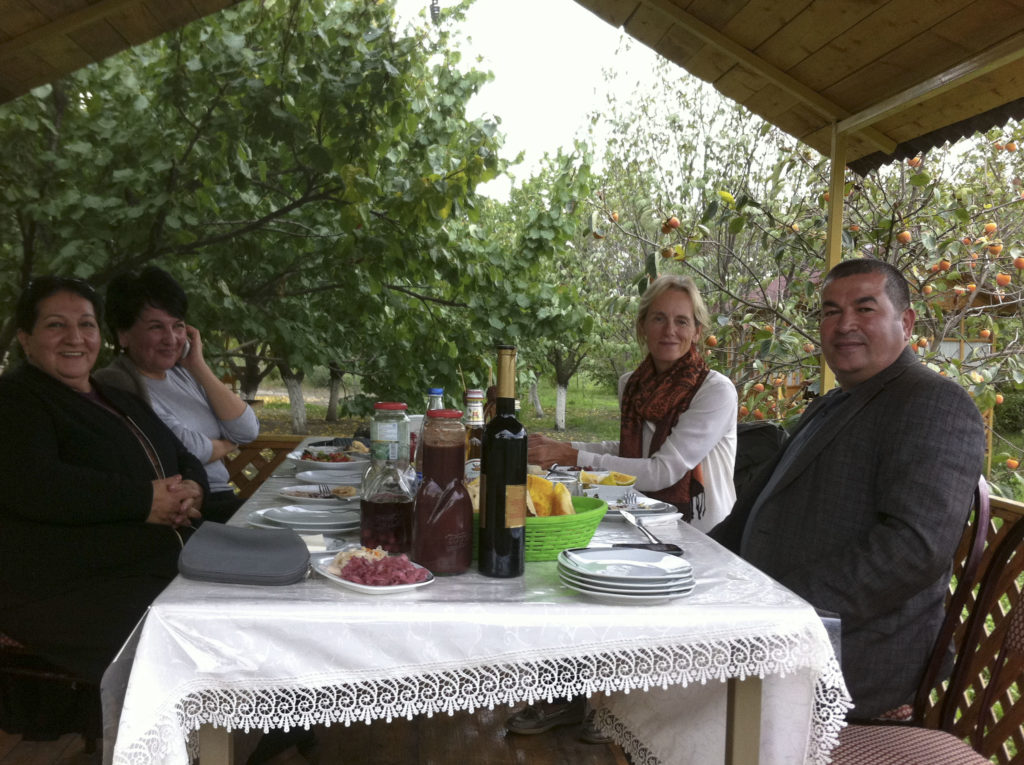
Restaurant Bizim Bagh lies on the outskirts of Goyçay, on an old road heading into the Caucasus Mountains. It is owned by a local man, Fuad, who runs the restaurant with his sons. As my friend, Firengiz, tells me, he is a self-made man. She remembers him selling single cigarettes on the streets, and slowly working his way up, and now he owns not only this restaurant, but the vast pomegranate orchards behind it.
Although the restaurant itself is a massive room, we chose on this unusually warm October evening to dine in the Garden Gazebos instead. We were the only guests that evening, and since Fuad was an old friend of Firengiz, he joined us for dinner. This was just one of many times in Azerbaijan when I had to speak through translators, Azerbaijani and English intermingling, lots of sign language and smiling.
The meal, all ordered for us by Fuad, (who also did not let us pay) began with fresh vegetables, cheeses and lavash, a type of flat bread. There were also many celebratory toasts back and forth with an Azerbaijani red wine. Lots of toasting. Lots of sign language. Lots of smiling.
Then came the first course: lamb between the stones.
Actually, I don’t like lamb as a rule, and I was not looking forward to eating it. But then I saw the thick, tender, juicy slices of perfectly-cooked lamb, swimming in juices with potatoes on the side. Incredible. And the piece de resistance of this dish, the freshly-made pomegranate sauce scooped over the top.
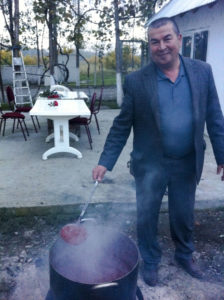
The rest of the meal
The Azerbaijani people know how to celebrate. That meal went on for several hours, course after course: more lamb, more wine, more toasting. Then sweet desserts and Samovar Tea. I was stuffed like a Khazak pheasant, but happy.
Believe it or not, I had to eat another entire five-course meal right after this when we visited another friend. The hospitality is undeniable. And Firengiz made me eat. I’m still full.
After dinner, I was given a tour of the grounds. There in a little shack in the garden are two heavy stone slabs over a low fire. His son lifts the stone to show me the slices of roasting lamb within. Just as the shepherds did around the campfires in the hills, Fuad says. And behind this shack, a big pot of Fuad’s simmering pomegranate sauce.
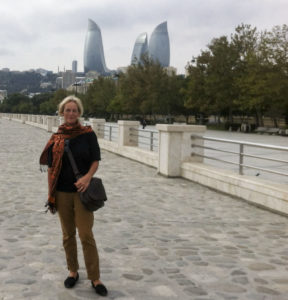
Lessons learned
People are people no matter where you go. You may not understand everything they do, but they work, eat, sleep, raise their children, and worry about the future — the same as we all do.
I always love learning about and experiencing new cultures and customs, but I also love knowing that we all have the same beating heart. Navigating another culture also teaches you about your own mettle.
Want to be a good and gracious visitor? Then be prepared to eat and drink outside your comfort zone, and enjoy!

